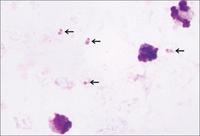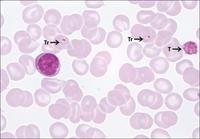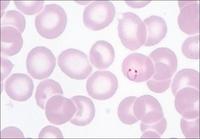A ‘thick blood film’ is prepared by spreading a drop of blood on a slide in a way that approximately 20 layers of erythrocytes are on top of each other. The slide is then left to dry and subsequently treated with Giemsa solution to lyse the erythrocytes. This process leads to a higher density of the malaria pathogens (here: trophozoites of Plasmodium falciparum <-) on the slide so that they can be detected more easily and quickly. The large nuclei are debris from lysed leukocytes.

|
|
|
|




